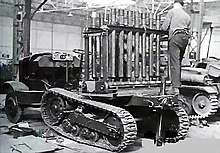Reihenwerfer
The Reihenwerfer or Mittler Schutzenpanzerwagen S307(f) mit Reihenwerfer was a self-propelled barrage mortar used by the Wehrmacht during World War II.
| Reihenwerfer | |
|---|---|
 A Reihenwerfer near Riva-Bella (Sword Beach), Atlantic coast, Northern France on 30 May 1944.[1] | |
| Type | Barrage Mortar |
| Place of origin | Nazi Germany |
| Service history | |
| Used by | Nazi Germany |
| Wars | Second World War |
| Production history | |
| Designer | Alfred Becker |
| Manufacturer | Alfred Becker |
| Specifications | |
| Mass | 7,118 kilograms (15,693 lb) |
| Length | 5.3 metres (17 ft 5 in) |
| Barrel length | 1.26 metres (4 ft 2 in) L/15.6 |
| Width | 2.17 metres (7 ft 1 in) |
| Height | 2.85 metres (9 ft 4 in)[2] |
| Shell weight | Light: 3.25 kg (7 lb 3 oz) Heavy: 6.5 kg (14 lb 5 oz) |
| Caliber | 81 mm (3.2 in) |
| Barrels | 16 |
| Carriage | SOMUA MCG |
| Elevation | +35° to +90° |
| Traverse | 360°[2] |
| Muzzle velocity | 174 m/s (570 ft/s) |
| Maximum firing range | Light: 2.8 km (1.7 mi) Heavy: 1.2 km (0.75 mi)[2] |
| Armor | 12 mm (0.47 in) |
Main armament | 16 x 81 mm GrW 278(f) mortars with 90 rounds of ammunition[2] |
Secondary armament | MG34 or MG42 |
| Engine | 4-cylinder, petrol, 4712 cc 60 hp (45 kW) |
| Transmission | 5+R |
| Suspension | Half-track |
| Fuel capacity | 80 l (21 US gal) |
Operational range | 180 km (110 mi) |
| Maximum speed | 31 km/h (19 mph)[3] |
History
After the Fall of France in 1940 large amounts of French military hardware fell into German hands. Two systems that were captured in sizable numbers were the SOMUA MCG half-track artillery tractor and the 81 mm Brandt Mle 27/31 mortar. Since the Germans were short of resources both were issued to German units. The SOMUA MCG was given the German designation S307(f) and the mle 27/31 was given the designation GrW 278(f).
The Reihenwerfer consisted of 16 GrW 278(f) barrels in two rows of 8 which were mounted on a common framework that was attached to a base mounted on the back of an armored S307(f) chassis. The mortars and half-tracks were converted by Major Alfred Becker's workshop (Baukommando Becker) in Paris. All 16 barrels could be traversed 360° and elevated together from +35° to +90°, with the outer barrels pointing slightly outwards to increase the spread of the barrage. The vehicle carried 90 rounds of ready use ammunition and each barrel held a single round at the top of the tube until fired by pulling a lanyard. The round then slid down the tube until it hit a firing pin which launched it. In action, all 16 barrels were fired in rapid succession, but not simultaneously to saturate the target area. The Reihenwerfer was deployed by German units in Northern France during the Normandy landings.[2]
Gallery
 A SOMUA half-track being modified.
A SOMUA half-track being modified..jpg) A Reihenwerfer on a SOMUA MCG.
A Reihenwerfer on a SOMUA MCG. A crew loading a Reihenwerfer near Riva-Bella (Sword Beach), Atlantic coast, Northern France on 30 May 1944.[1]
A crew loading a Reihenwerfer near Riva-Bella (Sword Beach), Atlantic coast, Northern France on 30 May 1944.[1]
Notes
- The description for both photos mistakenly identify the Reihenwerfer as a 8 cm Raketen-Vielfachwerfer.
- Chamberlain, Peter (1975). Mortars and rockets. Gander, Terry. New York: Arco Pub. Co. pp. 5-10. ISBN 0668038179. OCLC 2067459.
- "Ciągnik artyleryjski Ημιερπυστριοφόρο όχημα Somua MCG 5 | Encyklopedia Uzbrojenia II Wojny Światowej". www.dws-xip.pl (in Polish). Retrieved 2017-10-28.